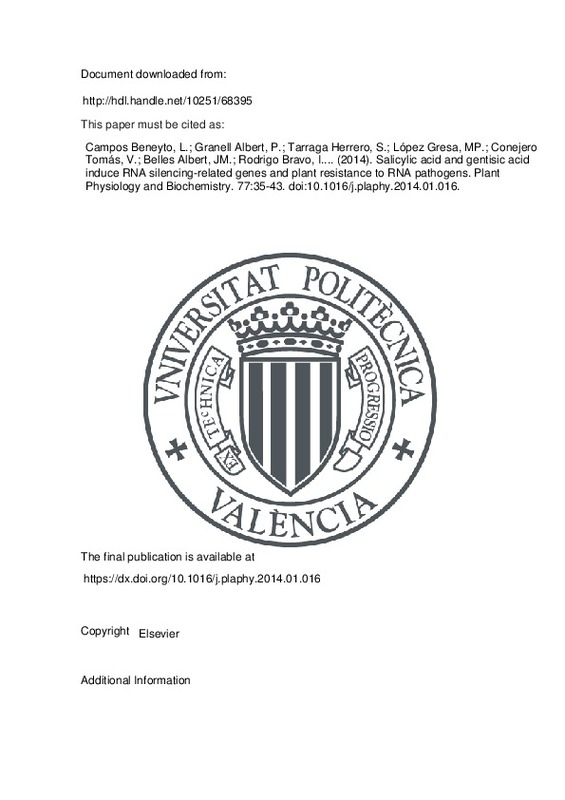JavaScript is disabled for your browser. Some features of this site may not work without it.
Buscar en RiuNet
Listar
Mi cuenta
Estadísticas
Ayuda RiuNet
Admin. UPV
Salicylic acid and gentisic acid induce RNA silencing-related genes and plant resistance to RNA pathogens
Mostrar el registro sencillo del ítem
Ficheros en el ítem
| dc.contributor.author | Campos Beneyto, Laura
|
es_ES |
| dc.contributor.author | Granell Albert, Pablo
|
es_ES |
| dc.contributor.author | Tarraga Herrero, Susana
|
es_ES |
| dc.contributor.author | López Gresa, Mª Pilar
|
es_ES |
| dc.contributor.author | Conejero Tomás, Vicente
|
es_ES |
| dc.contributor.author | Belles Albert, José Mª
|
es_ES |
| dc.contributor.author | Rodrigo Bravo, Ismael
|
es_ES |
| dc.contributor.author | Lisón Párraga, María Purificación
|
es_ES |
| dc.date.accessioned | 2016-07-28T11:56:09Z | |
| dc.date.available | 2016-07-28T11:56:09Z | |
| dc.date.issued | 2014-04 | |
| dc.identifier.issn | 0981-9428 | |
| dc.identifier.uri | http://hdl.handle.net/10251/68395 | |
| dc.description.abstract | [EN] We have observed that treatments with salicylic acid (SA) or gentisic acid (GA) induced resistance to RNA pathogens such as ToMV and CEVd in tomato and Gynura auriantiaca, respectively. Accumulation of SA and GA has been found to occur in plants infected by these pathogens, thus pointing out a possible defence role of both molecules. To study the molecular basis of the observed induced resistance to RNA pathogens the induction of silencing-related genes by SA and GA was considered. For that purpose, we searched for tomato genes which were orthologous to those described in Arabidopsis thaliana, such as AtDCL1, AtDCL2, AtDCL4, AtRDR1, AtRDR2 and AtRDR6, and we tracked their induction in tomato along virus and viroid infections. We observed that CEVd significantly induced all these genes in tomato, with the exception of ToRDR6, being the induction of ToDCL4 the most outstanding. Regarding the ToMV asymptomatic infection, with the exception of ToRDR2, we observed a significant induction of all the indicated silencing-related genes, being ToDCL2 the most induced gene. Subsequently, we analyzed their transcriptional activation by SA and at the time when ToMV was inoculated on plants. ToDCL2, ToRDR1 and ToRDR2 were significantly induced by both SA and GA, whereas ToDCL1 was only induced by SA. Such an induction resulted more effective by SA treatment, which is in agreement with the stronger SAinduced resistance observed. Our results suggest that the observed delay in the RNA pathogen accumulation could be due to the pre-induction of RNA silencing-related genes by SA or GA. 2014 Elsevier Masson SAS. All rights reserved | es_ES |
| dc.description.sponsorship | The authors are grateful to Cristina Torres and Asuncion Sauri for technical support. This work was supported by Grant BFU2009-11958 from Direccion General de Programas y Transferencia de Conocimiento, from Spanish Ministry of Science and Innovation, and Grants PAID-06-08-3295 and SP20120576 from Universitat Politecnica de Valencia (UPV). Laura Campos was the recipient of a predoctoral fellowship ACIF/2010/231 from Generalitat Valenciana (Spain). M<SUP>a</SUP> Pilar Lopez Gresa held a postdoctoral fellowship JAE-Doc_08_00402 from the Consejo Superior de Investigaciones Cientificas (Spain). | en_EN |
| dc.language | Inglés | es_ES |
| dc.publisher | Elsevier | es_ES |
| dc.relation.ispartof | Plant Physiology and Biochemistry | es_ES |
| dc.rights | Reserva de todos los derechos | es_ES |
| dc.subject | Resistance Salicylic acid | es_ES |
| dc.subject | Gentisic acid | es_ES |
| dc.subject | Gene silencing | es_ES |
| dc.subject | ToMV | es_ES |
| dc.subject | CEVd | es_ES |
| dc.subject | Tomato | es_ES |
| dc.subject.classification | BIOQUIMICA Y BIOLOGIA MOLECULAR | es_ES |
| dc.title | Salicylic acid and gentisic acid induce RNA silencing-related genes and plant resistance to RNA pathogens | es_ES |
| dc.type | Artículo | es_ES |
| dc.identifier.doi | 10.1016/j.plaphy.2014.01.016 | |
| dc.relation.projectID | info:eu-repo/grantAgreement/MICINN//BFU2009-11958/ES/Señalizacion Y Respuesta Defensiva De Las Plantas Frente A Patogenos/ | es_ES |
| dc.relation.projectID | info:eu-repo/grantAgreement/UPV//PAID-06-08-3295/ | es_ES |
| dc.relation.projectID | info:eu-repo/grantAgreement/UPV//SP20120576/ | es_ES |
| dc.relation.projectID | info:eu-repo/grantAgreement/GVA//ACIF%2F2010%2F231/ | es_ES |
| dc.relation.projectID | info:eu-repo/grantAgreement/CSIC//JAEDoc 08 00402/ | es_ES |
| dc.rights.accessRights | Abierto | es_ES |
| dc.contributor.affiliation | Universitat Politècnica de València. Instituto Universitario Mixto de Biología Molecular y Celular de Plantas - Institut Universitari Mixt de Biologia Molecular i Cel·lular de Plantes | es_ES |
| dc.contributor.affiliation | Universitat Politècnica de València. Departamento de Biotecnología - Departament de Biotecnologia | es_ES |
| dc.description.bibliographicCitation | Campos Beneyto, L.; Granell Albert, P.; Tarraga Herrero, S.; López Gresa, MP.; Conejero Tomás, V.; Belles Albert, JM.; Rodrigo Bravo, I.... (2014). Salicylic acid and gentisic acid induce RNA silencing-related genes and plant resistance to RNA pathogens. Plant Physiology and Biochemistry. 77:35-43. https://doi.org/10.1016/j.plaphy.2014.01.016 | es_ES |
| dc.description.accrualMethod | S | es_ES |
| dc.relation.publisherversion | https://dx.doi.org/10.1016/j.plaphy.2014.01.016 | es_ES |
| dc.description.upvformatpinicio | 35 | es_ES |
| dc.description.upvformatpfin | 43 | es_ES |
| dc.type.version | info:eu-repo/semantics/publishedVersion | es_ES |
| dc.description.volume | 77 | es_ES |
| dc.relation.senia | 259048 | es_ES |
| dc.contributor.funder | Ministerio de Ciencia e Innovación | es_ES |
| dc.contributor.funder | Generalitat Valenciana | es_ES |
| dc.contributor.funder | Universitat Politècnica de València | es_ES |
| dc.contributor.funder | Consejo Superior de Investigaciones Científicas | es_ES |







![[Cerrado]](/themes/UPV/images/candado.png)

